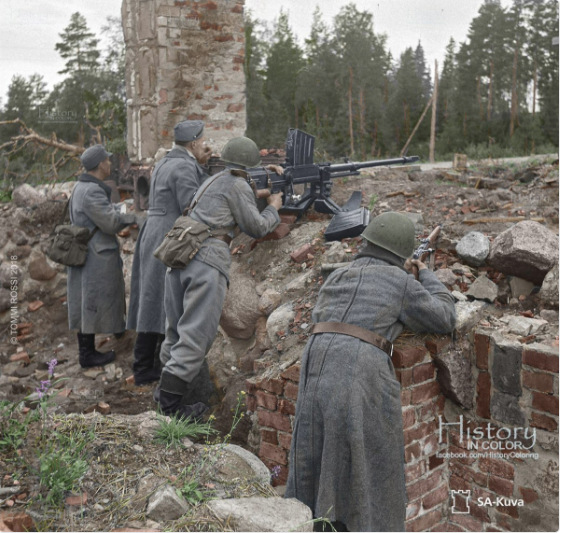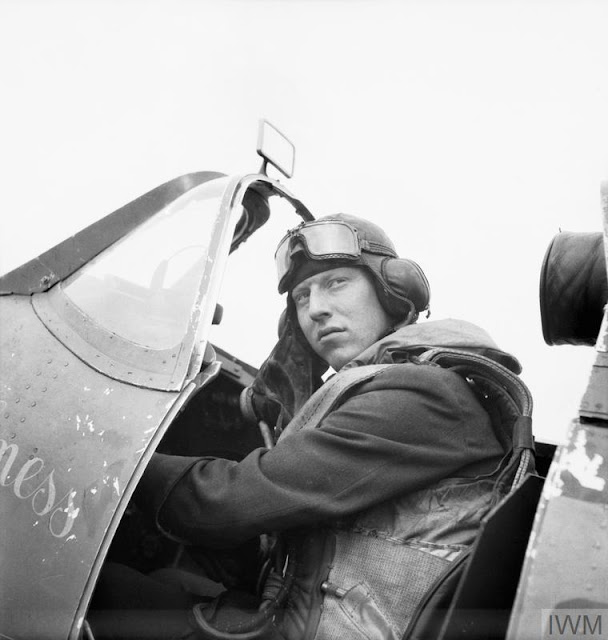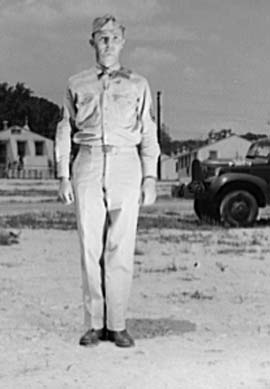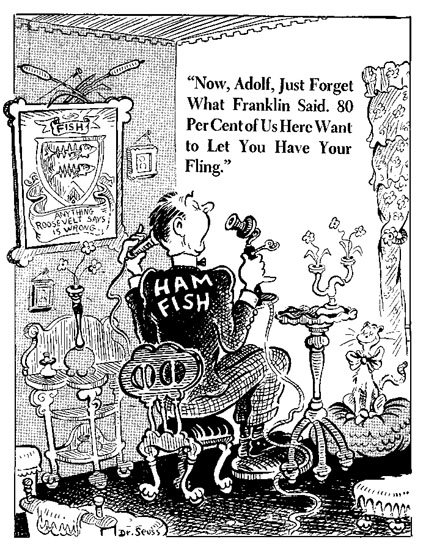Monday 25 August 1941
Iran Invasion: The British and Soviet Armies jointly invade Iran from different directions on 25 August 1941. The two nations divided Iran into separate spheres of influence in 1908, making the division of the country preordained. The invasion is an immediate success with no serious issues encountered by the invaders from either the defenders or the terrain.
In Operation Countenance, RAF aircraft based in Iraq beginning bombing Tehran, Qazvin, and other targets before dawn. The Royal Navy and Royal Australian Navy, under the command of Commodore Cosmo Graham, land at Abadan (Operation Demon), Khorramshahr and Bandar Shapur in the Persian Gulf. Resistance is extremely light, and the British sink two Iranian gunboats and quickly seize 7 Axis ships. The British are aided by clandestine reconnaissance missions conducted since the collapse of resistance in Iraq in May 1941. The invading units are organized as "Iraq Command."
The Soviet 44th, 47th and 53rd armies of the recently formed Transcaucasian Front (General Dmitry Timofeyevich Kozlov) invade by land primarily from Transcaucasia. The Soviets use about 1,000 T-26 tanks and quickly occupy large portions of Iran's northern provinces. Red Air Force and naval units also participate where they can be used, with planes bombing Tabriz, Ardabil, and Rasht.
The Iranian Army is taken by complete surprise. It mobilizes nine infantry divisions, two armored. The Iranians have good equipment, including the vz. 24 rifle that compares with the Wehrmacht's Mauser, and also has about 100 tanks (FT-6 and Panzer 38(t) light tanks that the Wehrmacht also uses). In addition, the Iranian army has La France TK-6 armored cars. However, the Iranian equipment by and large is obsolete, poorly handled, and overwhelmed by tactical surprise.
Iranian generals argue for a "scorched earth" policy of destroying bridges and other infrastructure in order to at least slow the invasion. Reza Shah refuses because he is proud of the great advances in roadways and buildings made in Iran during his reign and does not want to destroy them.
Iranian leader Rezā Shāh Pahlavi quickly summons Sir Reader Bullard and Andrey Andreyevich Smirnov, the British and Soviet ambassadors to Iran, to demand an explanation. They refer to two previous warnings made on 19 July and 17 August to expel German nationals which had not been carried out. There indeed are many Germans and Italians working on railways, telegraphs and the like, but they have been there for decades. Reza Shah also sends a telegram to US President Franklin D. Roosevelt. Roosevelt lamely responds that the "territorial integrity" of Iran should be respected, but otherwise does nothing.
Electricity goes out in Tehran at around 22:00, causing the lights to go out everywhere, including the Shah's palaces. For many Iranians, this is the first that they learn of the invasion.
By the end of the day, the British are control of Abadan after fierce hand-to-hand fighting around the refinery. There are light casualties on both sides, but the Iranian Naval Commander in Chief Rear Admiral Bayendor dies in defense of the naval base. Other areas such as Qasr Sheikh and Khorramshahr, both near Abadan also fall today. The Soviet troops capture Jolfa and drive south toward Tabriz and Lake Urmia against virtually no resistance. The Soviet Caspian Sea Flotilla (Rear-Admiral Sedelnikov) lands troops in Gilan Province wile 44th Army enters the same province by land. The Iranians score some rare successes at Pahlavi Harbour in Bandar Pahlavi, where they prevent a Soviet landing by sinking barges at the entrance to the harbor and fiercely defend Rasht.
Eastern Front: In the Far North sector, the Soviet 115th and 123rd Rifle Divisions continue their attempt to throw leading Finnish elements of Light Brigade T back across the Vuoksi river. Soviet artillery kills Light Brigade T's commander, Col. Tiiainen. Finnish reinforcements soon arrive, however, and force the Soviets back. Finnish reinforcements soon arrive, however, and force the Soviets back.
Further north, Finnish troops find themselves blocked in their attempt to cut the Murmansk railway line at Loukhi. General Hjalmar Siilasvuo, commander of III Corps, tells General Falkenhorst, commander of Army of Norway, that the attack has failed and that he needs a fresh Finnish division to resume the offensive. Falkenhorst arranges a meeting with Siilasvuo for the 29th.
Finnish 36 Corps, operating between Nurmi Lake and Nurmi Mountain, is trying to cut off Soviet troops who have discovered an unmarked logging road. The Finns managed to cut the escape route today, trapping at least some of the fleeing Soviet troops. The weather improves, and bombers and dive-bombers are able to attack the Soviet troops. The Soviets, though, refuse to give up on their escape route and fight savagely to reopen it.
In the Army Group North sector, the Germans capture Novgorod south of Leningrad. German LVI Corps (General von Manstein) and 39 Corps (motorized) attack east of the Volkhov River toward Lyuban and the Neva River. The Soviets defend with the 4th, 52nd, and 54th Armies. German LVI Corps pushes the Soviet 34th and 11th Armies back to the Lovat River.
In the Army Group Center sector, General Guderian has Panzer Group 2 begin its offensive south toward Kyiv from Starodub, while the 2nd Army also joins in 75 miles to the west. Second Army quickly seizes a key bridge, but Panzer Group 2 just as quickly runs into fierce Soviet resistance which slows his advance to a crawl. Panzer Group 3 continues fighting into Velikiye Luki.
In the Army Group South sector, General von Kleist's Panzer Group 2 captures Dnepropetrovsk south of Kyiv. Kleist aims to secure the town and its important river crossing and then head north to meet Guderian's Panzer Group 2 heading south to encircle the Soviet troops at Kyiv. Fighting dies down on the Odesa perimeter, with the Romanians relying on artillery based at Kubanka to wear down the defending Soviet troops.
Luftwaffe ace Hermann-Friedrich Joppien, an Experten with 70 victories (42 on the Western Front), is shot down and killed southwest of Bryansk. A Soviet Polikarpov I-16 fighter shoots him down while Joppien and his wingman are attacking three Petlyakov Pe-2 bombers. He receives a posthumous Wehrmachtbericht mention on 29 August 1941, his third mention.
European Air Operations: During the day, RAF Bomber Command sends six Blenheim bombers on a routine patrol to the mouth of the River Scheldt without incident.
During the night, the RAF sends 37 Wellington and 12 Stirlings against Karlsruhe and 38 Hampden and 7 Manchester bombers against Mannheim. There are 2 Wellingtons and one Stirling lost on the Karlsruhe raid and 3 Hampdens lost over Mannheim. The weather is poor over Karlsruhe, leading to poor accuracy, while the RAF does moderate damage to Mannheim.
One of the Vickers Wellington bombers going to Karlsruhe doesn't make it for an odd reason. Near Niederdonven, a bolt of lightning strikes it, causing the plane to explode. All six crewmen perish and are temporarily buried in Niederdonven cemetery, where a memorial plaque is placed.
There are scattered Luftwaffe raids across northeast England, with reports of five reconnaissance aircraft crossing the coast. Slight damage at Ashington, Whitley Bay, and Wallsend.
Battle of the Baltic: The German 3rd S-Boat Flotilla lays 30 TMB mines off Cape Ristna (Dago). German minelayers Brummer and Roland lay 170 EMC mines in minefield Rusto north of Cape Ristna.
The Luftwaffe bombs and sinks Soviet tanker Zheleznodrozhnik and freighters Daugava and Lunacharsk. There are seven deaths on the Lunacharski.
Soviet icebreaker Truvor hits a mine and sinks in the Gulf of Finland. There are 22 survivors.
Auxiliary Soviet river gunboat Vernyy is sunk during action while assisting the Red Army.
Battle of the Atlantic: Royal Navy antisubmarine trawler HMS Vascama (Lt Walgate) joins with an RAF Catalina J of No. 209 Squadron based at Reykjavik, Iceland to sink U-452 south of Iceland. U-452 (Kptlt. Jürgen March) was on its first patrol out of Trondheim. All 42 men on the submarine perish.
U-752 (Karl-Ernst Schroeter), on its first patrol out of Kirkenes, torpedoes and sinks 553-ton-ton Soviet minesweeping trawler Dvina (T-898 (No. 44)) about 80 miles east of Cape Chernyj northwest of Svyatoy, Russia. Some accounts state that U-752 also torpedoes auxiliary minesweeper Nenets as well, but that may refer to the same ship by another name.
Royal Navy minelayers Adventure, Port Quebec, and Southern Prince lay minefield SN-70A in the North Atlantic. While returning to port, 10,917-ton Southern Prince is spotted by U-652 (Oblt. Georg-Werner Fraatz), which is on its second patrol out of Trondheim, and torpedoed and damaged midway between Iceland and the Faroe Islands. There are no casualties, and Southern Prince makes it back to Scapa Flow and later Belfast for repairs.
Royal Navy destroyer Newark, formerly USS Ringgold, is torpedoed while in the company of Southern Prince. It is towed into Belfast for repairs. It is under repair until May 1942. It is unclear if U-652 also hit Newark or if it was another vessel or plane.
German 2288-ton freighter Troyburg is stranded and lost at Farsund, southwest Norway.
US aircraft carrier USS Wasp leads American Task Group TG.2.6 on a neutrality patrol out of Hampton Roads today.
Royal Navy minelayer HMS Welshman (Captain Wiliam H. D. Friedberger) is commissioned and corvette Loosestrife is launched.
United States Navy submarine USS Finback is launched.
U-333 (Kptlt. Peter Erich Cremer) is commissioned. The Kriegsmarine places orders for 61 new U-boats.
Battle of the Mediterranean: Operation Treacle, the replacement of Australian troops at Tobruk with Polish troops of the Carpathian Brigade, continues. Minelaying cruiser Abdiel and destroyers Jackal, Hasty, and Kandahar take the troops from Alexandria to Tobruk late in the day. The Luftwaffe spots them and attacks at twilight but scores no hits.
Royal Navy minelayer Manxman completes laying its mines off of Livorno, Italy as part of Operation Mincemeat and heads back to Gibraltar.
Royal Navy submarine Rorqual (Lt. Napier) lays mines off Cape Skinari, Greece.
Nine Wellington bombers based on Malta attack Tripoli, causing moderate damage. One Wellington crashes while landing at Luqa airfield.
Battle of the Pacific: German blockade river Munsterland departs from Yokohama carrying supplies for other raiders in the Pacific.
Special Forces: Operation Gauntlet, a raid on Spitzbergen, begins at 04:30 when destroyer HMS Icarus lands a signal party at the Kap Linne radio station at the entrance to Isfjoren on Spitzbergen Island. At first, the local Norwegians think the soldiers are Germans, but soon spot the flag of Norway on an officer's shoulder. Finding no resistance (the Norwegians are happy to see the British and there are no Germans), the Royal Navy ships steam into Isfjorden and then on to Grønfjorden at 08:00. The ships anchor at Barentsburg, populated by Russians who also are happy to see the Royal Navy. Brigadier Arthur Poss, commander of the 2nd Canadian Infantry Brigade, goes ashore and offers the Russians safe transport to Archangelsk if they wish. Facing no opposition, other Canadian units occupy strategic points along the coast. The locals now have a tough choice of whether to stay on the island or be evacuated.
German/Italian Relations: Mussolini visits Hitler at the latter's headquarters at the Wolfsschanze (Wolf's Lair) headquarters in East Prussia along with Italian Foreign Minister Count Ciano. Hitler rails against Franco, who still refuses to join the war, while Mussolini complains that his army is disloyal. Hitler asks for more Italian troops to take over garrison duty in the Balkans to free up German troops to serve on the Eastern Front. The men then depart for an inspection tour of captured towns in Ukraine. This will be Mussolini's longest visit with Hitler of the war, lasting until 29 August.
German/Japanese Relations: Hitler meets with Japanese Ambassador Hiroshi Oshima in East Prussia.
US/Italian Relations: US authorities seize 5039-ton Italian tanker Colorado at San Juan, Puerto Rico. It is renamed Typhoon under Panamanian registration.
German Military: Ernst Udet, Director-general of Equipment for the Luftwaffe, reports sick. Udet indeed is sick, but it is not a physical illness - he is beset by depression and raging paranoia.
In essence, Udet's job is to decide what plane designs get built and which to terminate. An ace pilot and World War I hero, Udet finds administrative work extremely stressful - though he is good at it and largely responsible for turning the Luftwaffe into a deadly instrument of war. Udet is a great friend of Reichsmarschall Hermann Goering, to whom he owes his position, and feels that he has let both Goering and himself down by failing in the Battle of Britain. Udet is replaced for the time being by Inspector General Erhard Milch.
Soviet Military: General Malinovsky takes over the Soviet 6th Army.
Japanese Military: The Imperial Japanese Navy begins converting 10,020-ton tanker Shinkoku Maru into a naval auxiliary at Naniwa Dockyard, Osaka.
US Military: Richard "Dick" Winters enlists in US Army. He becomes famous later in the war for commanding Easy Company of the 2nd Battalion, 506th Parachute Infantry Regiment, part of the 101st Airborne Division. He is a major character in "Band of Brothers" (2001).
Holocaust: In the Tykocin pogrom, the SS takes about 1400-1700 Jewish residents of Tykocin in occupied Poland to nearby Łopuchowo forest and execute them.
German SS and civilian authorities meet at Vinnytsia, Ukraine to discuss the fate of 20,000 Hungarian Jews interned at Kamianets-Podilskyi, Ukraine. The plan arrived at is to liquidate them by 1 September.
German authorities in Belgrade transport about 8000 Jewish residents to Topovske Supe for execution.
Norwegian Homefront: A group of about 20 Norwegian citizens attempting to flee the Germans boards fishing boat "Hod" at Ulstein. They leave for England on the evening of 25 August 1941. The boat is never seen again, but one woman's body is found later offshore and the boat's registration plate and some parts of it are later found. It is speculated that a German patrol plane spotted the boat offshore and bombed it.
August 1941
August 1, 1941: More Executions on Crete
August 2, 1941: Uman Encirclement Closes
August 3, 1941: Bishop von Galen Denounces Euthanasia
August 4, 1941: Hitler at the Front
August 5, 1941: Soviets Surrender at Smolensk
August 6, 1941: U-Boats in the Arctic
August 7, 1941: Soviets Bomb Berlin
August 8, 1941: Uman Pocket Captured
August 9, 1941: Atlantic Conference at Placentia Bay
August 10, 1941: Soviet Bombers Mauled Over Berlin
August 11, 1941: Rita Hayworth in Life
August 12, 1941: Atlantic Charter Announced
August 13, 1941: The Soybean Car
August 14, 1941: The Anders Army Formed
August 15, 1941: Himmler at Minsk
August 16, 1941: Stalin's Order No. 270
August 17, 1941: Germans in Novgorod
August 18, 1941: Lili Marleen
August 19, 1941: Convoy OG-71 Destruction
August 20, 1941: Siege of Leningrad Begins
August 21, 1941: Stalin Enraged
August 22, 1941: Germans Take Cherkassy
August 23, 1941: Go to Kiev
August 24, 1941: Finns Surround Viipuri
August 25, 1941: Iran Invaded
August 26, 1941: The Bridge Over the Desna
August 27, 1941: Soviets Evacuate Tallinn
August 28, 1941: Evacuating Soviets Savaged
August 29, 1941: Finns take Viipuri
August 30, 1941: Operation Acid
August 31, 1941: Mannerheim Says No
2020
In Operation Countenance, RAF aircraft based in Iraq beginning bombing Tehran, Qazvin, and other targets before dawn. The Royal Navy and Royal Australian Navy, under the command of Commodore Cosmo Graham, land at Abadan (Operation Demon), Khorramshahr and Bandar Shapur in the Persian Gulf. Resistance is extremely light, and the British sink two Iranian gunboats and quickly seize 7 Axis ships. The British are aided by clandestine reconnaissance missions conducted since the collapse of resistance in Iraq in May 1941. The invading units are organized as "Iraq Command."
 |
| Soviet troops of the 44th Army cross the Iranian border, 25 August 1941. |
The Iranian Army is taken by complete surprise. It mobilizes nine infantry divisions, two armored. The Iranians have good equipment, including the vz. 24 rifle that compares with the Wehrmacht's Mauser, and also has about 100 tanks (FT-6 and Panzer 38(t) light tanks that the Wehrmacht also uses). In addition, the Iranian army has La France TK-6 armored cars. However, the Iranian equipment by and large is obsolete, poorly handled, and overwhelmed by tactical surprise.
Iranian generals argue for a "scorched earth" policy of destroying bridges and other infrastructure in order to at least slow the invasion. Reza Shah refuses because he is proud of the great advances in roadways and buildings made in Iran during his reign and does not want to destroy them.
Iranian leader Rezā Shāh Pahlavi quickly summons Sir Reader Bullard and Andrey Andreyevich Smirnov, the British and Soviet ambassadors to Iran, to demand an explanation. They refer to two previous warnings made on 19 July and 17 August to expel German nationals which had not been carried out. There indeed are many Germans and Italians working on railways, telegraphs and the like, but they have been there for decades. Reza Shah also sends a telegram to US President Franklin D. Roosevelt. Roosevelt lamely responds that the "territorial integrity" of Iran should be respected, but otherwise does nothing.
Electricity goes out in Tehran at around 22:00, causing the lights to go out everywhere, including the Shah's palaces. For many Iranians, this is the first that they learn of the invasion.
By the end of the day, the British are control of Abadan after fierce hand-to-hand fighting around the refinery. There are light casualties on both sides, but the Iranian Naval Commander in Chief Rear Admiral Bayendor dies in defense of the naval base. Other areas such as Qasr Sheikh and Khorramshahr, both near Abadan also fall today. The Soviet troops capture Jolfa and drive south toward Tabriz and Lake Urmia against virtually no resistance. The Soviet Caspian Sea Flotilla (Rear-Admiral Sedelnikov) lands troops in Gilan Province wile 44th Army enters the same province by land. The Iranians score some rare successes at Pahlavi Harbour in Bandar Pahlavi, where they prevent a Soviet landing by sinking barges at the entrance to the harbor and fiercely defend Rasht.
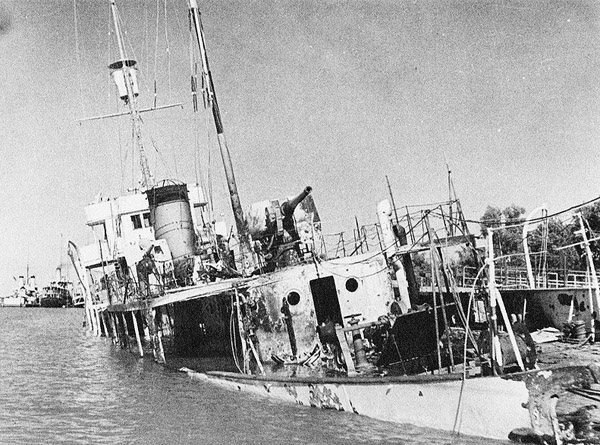 |
| Iranian gunboat Babr sunk at Khorramshar, Iran, on 25 August 1941 (Iranian government). |
Further north, Finnish troops find themselves blocked in their attempt to cut the Murmansk railway line at Loukhi. General Hjalmar Siilasvuo, commander of III Corps, tells General Falkenhorst, commander of Army of Norway, that the attack has failed and that he needs a fresh Finnish division to resume the offensive. Falkenhorst arranges a meeting with Siilasvuo for the 29th.
Finnish 36 Corps, operating between Nurmi Lake and Nurmi Mountain, is trying to cut off Soviet troops who have discovered an unmarked logging road. The Finns managed to cut the escape route today, trapping at least some of the fleeing Soviet troops. The weather improves, and bombers and dive-bombers are able to attack the Soviet troops. The Soviets, though, refuse to give up on their escape route and fight savagely to reopen it.
 |
| A young Soviet soldier in a BA-20 light armored car. Red Army armor crossed the Iranian border on 25 August. 1941. |
In the Army Group Center sector, General Guderian has Panzer Group 2 begin its offensive south toward Kyiv from Starodub, while the 2nd Army also joins in 75 miles to the west. Second Army quickly seizes a key bridge, but Panzer Group 2 just as quickly runs into fierce Soviet resistance which slows his advance to a crawl. Panzer Group 3 continues fighting into Velikiye Luki.
In the Army Group South sector, General von Kleist's Panzer Group 2 captures Dnepropetrovsk south of Kyiv. Kleist aims to secure the town and its important river crossing and then head north to meet Guderian's Panzer Group 2 heading south to encircle the Soviet troops at Kyiv. Fighting dies down on the Odesa perimeter, with the Romanians relying on artillery based at Kubanka to wear down the defending Soviet troops.
Luftwaffe ace Hermann-Friedrich Joppien, an Experten with 70 victories (42 on the Western Front), is shot down and killed southwest of Bryansk. A Soviet Polikarpov I-16 fighter shoots him down while Joppien and his wingman are attacking three Petlyakov Pe-2 bombers. He receives a posthumous Wehrmachtbericht mention on 29 August 1941, his third mention.
 |
| Hauptmann Hermann-Friedrich Joppien, Kommandeur of I./JG 51. KIA 25 August 1941 in the Soviet Union. |
During the night, the RAF sends 37 Wellington and 12 Stirlings against Karlsruhe and 38 Hampden and 7 Manchester bombers against Mannheim. There are 2 Wellingtons and one Stirling lost on the Karlsruhe raid and 3 Hampdens lost over Mannheim. The weather is poor over Karlsruhe, leading to poor accuracy, while the RAF does moderate damage to Mannheim.
One of the Vickers Wellington bombers going to Karlsruhe doesn't make it for an odd reason. Near Niederdonven, a bolt of lightning strikes it, causing the plane to explode. All six crewmen perish and are temporarily buried in Niederdonven cemetery, where a memorial plaque is placed.
There are scattered Luftwaffe raids across northeast England, with reports of five reconnaissance aircraft crossing the coast. Slight damage at Ashington, Whitley Bay, and Wallsend.
Battle of the Baltic: The German 3rd S-Boat Flotilla lays 30 TMB mines off Cape Ristna (Dago). German minelayers Brummer and Roland lay 170 EMC mines in minefield Rusto north of Cape Ristna.
The Luftwaffe bombs and sinks Soviet tanker Zheleznodrozhnik and freighters Daugava and Lunacharsk. There are seven deaths on the Lunacharski.
Soviet icebreaker Truvor hits a mine and sinks in the Gulf of Finland. There are 22 survivors.
Auxiliary Soviet river gunboat Vernyy is sunk during action while assisting the Red Army.
 |
| HMS Newark, damaged on 25 August 1941 (© IWM (FL 3299)). |
U-752 (Karl-Ernst Schroeter), on its first patrol out of Kirkenes, torpedoes and sinks 553-ton-ton Soviet minesweeping trawler Dvina (T-898 (No. 44)) about 80 miles east of Cape Chernyj northwest of Svyatoy, Russia. Some accounts state that U-752 also torpedoes auxiliary minesweeper Nenets as well, but that may refer to the same ship by another name.
Royal Navy minelayers Adventure, Port Quebec, and Southern Prince lay minefield SN-70A in the North Atlantic. While returning to port, 10,917-ton Southern Prince is spotted by U-652 (Oblt. Georg-Werner Fraatz), which is on its second patrol out of Trondheim, and torpedoed and damaged midway between Iceland and the Faroe Islands. There are no casualties, and Southern Prince makes it back to Scapa Flow and later Belfast for repairs.
Royal Navy destroyer Newark, formerly USS Ringgold, is torpedoed while in the company of Southern Prince. It is towed into Belfast for repairs. It is under repair until May 1942. It is unclear if U-652 also hit Newark or if it was another vessel or plane.
German 2288-ton freighter Troyburg is stranded and lost at Farsund, southwest Norway.
US aircraft carrier USS Wasp leads American Task Group TG.2.6 on a neutrality patrol out of Hampton Roads today.
Royal Navy minelayer HMS Welshman (Captain Wiliam H. D. Friedberger) is commissioned and corvette Loosestrife is launched.
United States Navy submarine USS Finback is launched.
U-333 (Kptlt. Peter Erich Cremer) is commissioned. The Kriegsmarine places orders for 61 new U-boats.
 |
| "Small boys prefer to smoke cigarettes than eat candy. In this picture, a 2.5-year-old tot easily identifiable as male." - Russo-Finnish front, 25 August 1941. |
Royal Navy minelayer Manxman completes laying its mines off of Livorno, Italy as part of Operation Mincemeat and heads back to Gibraltar.
Royal Navy submarine Rorqual (Lt. Napier) lays mines off Cape Skinari, Greece.
Nine Wellington bombers based on Malta attack Tripoli, causing moderate damage. One Wellington crashes while landing at Luqa airfield.
Battle of the Pacific: German blockade river Munsterland departs from Yokohama carrying supplies for other raiders in the Pacific.
 |
| Soldiers of the Waffen-SS looking over a map on the Eastern Front, 25 August 1941. |
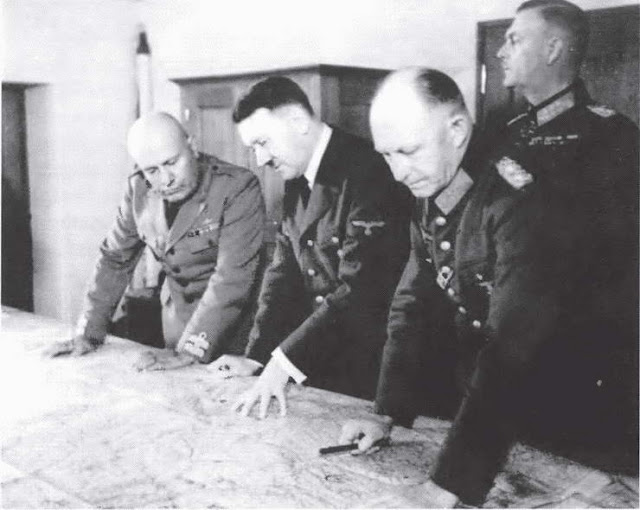 |
| The Italian dictator Benito Mussolini, Hitler, Major-General Alfred Jodl and Field Marshal Wilhelm Keitel confer at Hitler’s headquarters in East Prussia, the Wolfsschanze, on 25 August 1941. |
German/Japanese Relations: Hitler meets with Japanese Ambassador Hiroshi Oshima in East Prussia.
US/Italian Relations: US authorities seize 5039-ton Italian tanker Colorado at San Juan, Puerto Rico. It is renamed Typhoon under Panamanian registration.
 |
| Soviet soldiers gathered outside the headquarters established at the only hotel in Qazvin, Iran, 1941 (George Rodgers). |
Italian/Argentinian Relations: The Argentine government seizes 16 Italian freighters in Argentine ports and puts them into Argentine service under new names.
German Military: Ernst Udet, Director-general of Equipment for the Luftwaffe, reports sick. Udet indeed is sick, but it is not a physical illness - he is beset by depression and raging paranoia.
In essence, Udet's job is to decide what plane designs get built and which to terminate. An ace pilot and World War I hero, Udet finds administrative work extremely stressful - though he is good at it and largely responsible for turning the Luftwaffe into a deadly instrument of war. Udet is a great friend of Reichsmarschall Hermann Goering, to whom he owes his position, and feels that he has let both Goering and himself down by failing in the Battle of Britain. Udet is replaced for the time being by Inspector General Erhard Milch.
Soviet Military: General Malinovsky takes over the Soviet 6th Army.
Japanese Military: The Imperial Japanese Navy begins converting 10,020-ton tanker Shinkoku Maru into a naval auxiliary at Naniwa Dockyard, Osaka.
 |
| Fred Astaire and son on the cover of Life magazine, 25 August 1941. |
Holocaust: In the Tykocin pogrom, the SS takes about 1400-1700 Jewish residents of Tykocin in occupied Poland to nearby Łopuchowo forest and execute them.
German SS and civilian authorities meet at Vinnytsia, Ukraine to discuss the fate of 20,000 Hungarian Jews interned at Kamianets-Podilskyi, Ukraine. The plan arrived at is to liquidate them by 1 September.
German authorities in Belgrade transport about 8000 Jewish residents to Topovske Supe for execution.
 |
| Fishing/excursion boat "Hod." |
 |
| Members of the Italian Consulate in Essen. Note Queen Elena's picture on the wall (Federal Archive, Bild 212-303). |
August 1941
August 2, 1941: Uman Encirclement Closes
August 3, 1941: Bishop von Galen Denounces Euthanasia
August 4, 1941: Hitler at the Front
August 5, 1941: Soviets Surrender at Smolensk
August 6, 1941: U-Boats in the Arctic
August 7, 1941: Soviets Bomb Berlin
August 8, 1941: Uman Pocket Captured
August 9, 1941: Atlantic Conference at Placentia Bay
August 10, 1941: Soviet Bombers Mauled Over Berlin
August 11, 1941: Rita Hayworth in Life
August 12, 1941: Atlantic Charter Announced
August 13, 1941: The Soybean Car
August 14, 1941: The Anders Army Formed
August 15, 1941: Himmler at Minsk
August 16, 1941: Stalin's Order No. 270
August 17, 1941: Germans in Novgorod
August 18, 1941: Lili Marleen
August 19, 1941: Convoy OG-71 Destruction
August 20, 1941: Siege of Leningrad Begins
August 21, 1941: Stalin Enraged
August 22, 1941: Germans Take Cherkassy
August 23, 1941: Go to Kiev
August 24, 1941: Finns Surround Viipuri
August 25, 1941: Iran Invaded
August 26, 1941: The Bridge Over the Desna
August 27, 1941: Soviets Evacuate Tallinn
August 28, 1941: Evacuating Soviets Savaged
August 29, 1941: Finns take Viipuri
August 30, 1941: Operation Acid
August 31, 1941: Mannerheim Says No
2020
